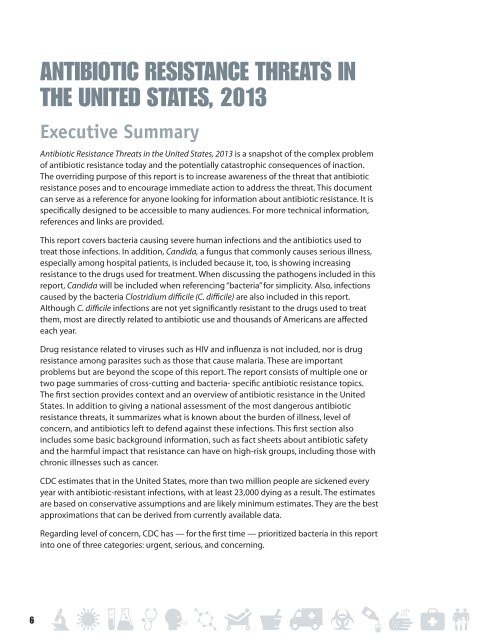Antibiotic Resistance Threats in the United States, 2013 report
Antibiotic Resistance Threats in the United States, 2013 report
Antibiotic Resistance Threats in the United States, 2013 report
You also want an ePaper? Increase the reach of your titles
YUMPU automatically turns print PDFs into web optimized ePapers that Google loves.
ANTIBIOTIC RESISTANCE THREATS IN<br />
THE UNITED STATES, <strong>2013</strong><br />
Executive Summary<br />
<strong>Antibiotic</strong> <strong>Resistance</strong> <strong>Threats</strong> <strong>in</strong> <strong>the</strong> <strong>United</strong> <strong>States</strong>, <strong>2013</strong> is a snapshot of <strong>the</strong> complex problem<br />
of antibiotic resistance today and <strong>the</strong> potentially catastrophic consequences of <strong>in</strong>action.<br />
The overrid<strong>in</strong>g purpose of this <strong>report</strong> is to <strong>in</strong>crease awareness of <strong>the</strong> threat that antibiotic<br />
resistance poses and to encourage immediate action to address <strong>the</strong> threat. This document<br />
can serve as a reference for anyone look<strong>in</strong>g for <strong>in</strong>formation about antibiotic resistance. It is<br />
specifically designed to be accessible to many audiences. For more technical <strong>in</strong>formation,<br />
references and l<strong>in</strong>ks are provided.<br />
This <strong>report</strong> covers bacteria caus<strong>in</strong>g severe human <strong>in</strong>fections and <strong>the</strong> antibiotics used to<br />
treat those <strong>in</strong>fections. In addition, Candida, a fungus that commonly causes serious illness,<br />
especially among hospital patients, is <strong>in</strong>cluded because it, too, is show<strong>in</strong>g <strong>in</strong>creas<strong>in</strong>g<br />
resistance to <strong>the</strong> drugs used for treatment. When discuss<strong>in</strong>g <strong>the</strong> pathogens <strong>in</strong>cluded <strong>in</strong> this<br />
<strong>report</strong>, Candida will be <strong>in</strong>cluded when referenc<strong>in</strong>g “bacteria” for simplicity. Also, <strong>in</strong>fections<br />
caused by <strong>the</strong> bacteria Clostridium difficile (C. difficile) are also <strong>in</strong>cluded <strong>in</strong> this <strong>report</strong>.<br />
Although C. difficile <strong>in</strong>fections are not yet significantly resistant to <strong>the</strong> drugs used to treat<br />
<strong>the</strong>m, most are directly related to antibiotic use and thousands of Americans are affected<br />
each year.<br />
Drug resistance related to viruses such as HIV and <strong>in</strong>fluenza is not <strong>in</strong>cluded, nor is drug<br />
resistance among parasites such as those that cause malaria. These are important<br />
problems but are beyond <strong>the</strong> scope of this <strong>report</strong>. The <strong>report</strong> consists of multiple one or<br />
two page summaries of cross-cutt<strong>in</strong>g and bacteria- specific antibiotic resistance topics.<br />
The first section provides context and an overview of antibiotic resistance <strong>in</strong> <strong>the</strong> <strong>United</strong><br />
<strong>States</strong>. In addition to giv<strong>in</strong>g a national assessment of <strong>the</strong> most dangerous antibiotic<br />
resistance threats, it summarizes what is known about <strong>the</strong> burden of illness, level of<br />
concern, and antibiotics left to defend aga<strong>in</strong>st <strong>the</strong>se <strong>in</strong>fections. This first section also<br />
<strong>in</strong>cludes some basic background <strong>in</strong>formation, such as fact sheets about antibiotic safety<br />
and <strong>the</strong> harmful impact that resistance can have on high-risk groups, <strong>in</strong>clud<strong>in</strong>g those with<br />
chronic illnesses such as cancer.<br />
CDC estimates that <strong>in</strong> <strong>the</strong> <strong>United</strong> <strong>States</strong>, more than two million people are sickened every<br />
year with antibiotic-resistant <strong>in</strong>fections, with at least 23,000 dy<strong>in</strong>g as a result. The estimates<br />
are based on conservative assumptions and are likely m<strong>in</strong>imum estimates. They are <strong>the</strong> best<br />
approximations that can be derived from currently available data.<br />
Regard<strong>in</strong>g level of concern, CDC has — for <strong>the</strong> first time — prioritized bacteria <strong>in</strong> this <strong>report</strong><br />
<strong>in</strong>to one of three categories: urgent, serious, and concern<strong>in</strong>g.<br />
6
















